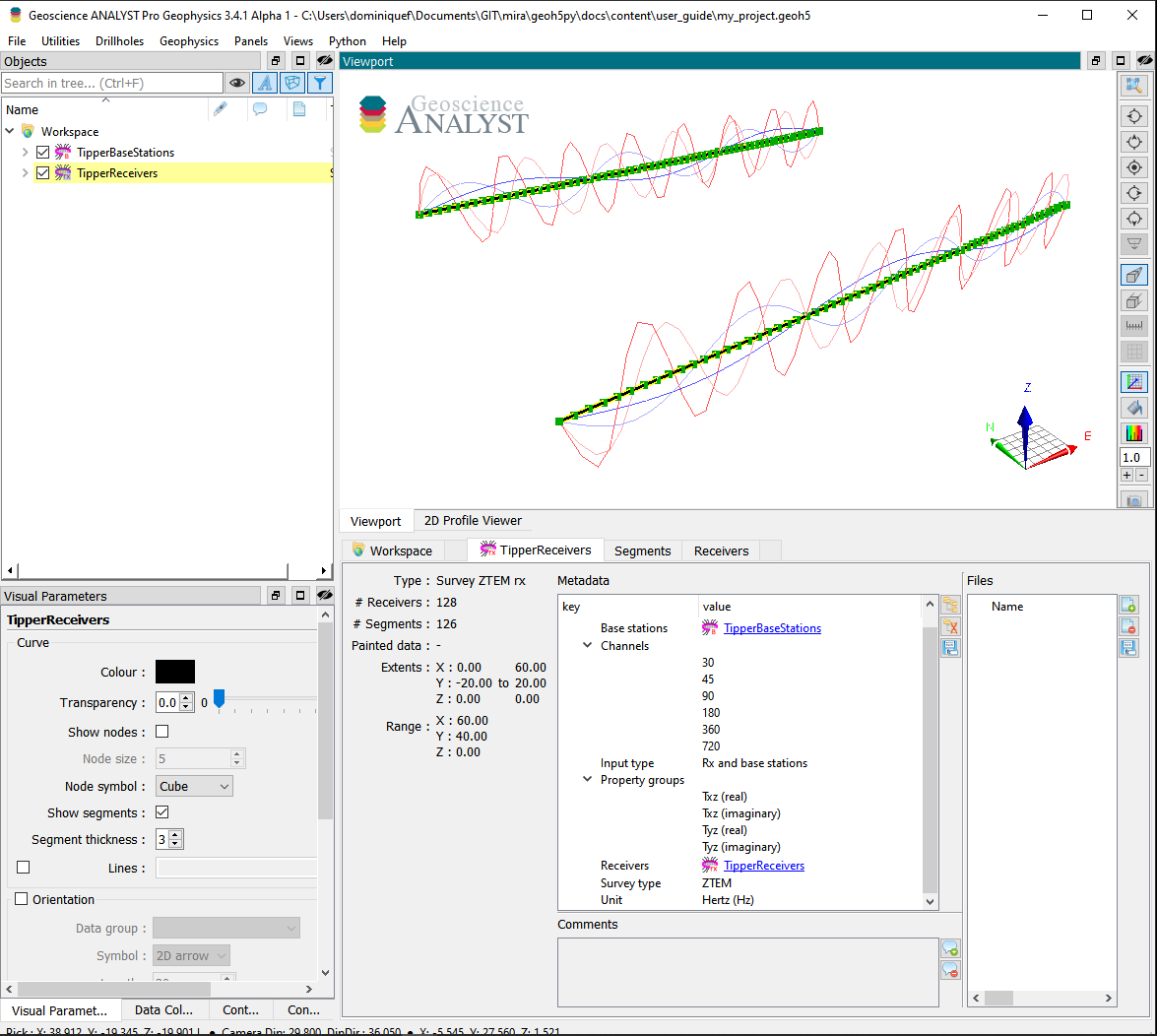Tipper¶
This object can be used to store tipper (ZTEM) surveys - a natural-source geophysical method. Data are provided in the frequency-domain as point source measurements of tipper data.
The following example shows how to generate a tipper survey with associated data stored in geoh5 format and accessible from Geoscience ANALYST.

[1]:
import numpy as np
from geoh5py.workspace import Workspace
from geoh5py.objects import TipperReceivers, TipperBaseStations
# Create a new project
workspace = Workspace("my_project.geoh5")
# Define the pole locations
n_stations = 64
n_lines = 2
x_loc, y_loc = np.meshgrid(np.linspace(0, 60, n_stations), np.linspace(-20, 20., n_lines))
vertices = np.c_[x_loc.ravel(), y_loc.ravel(), np.zeros_like(x_loc).ravel()]
# Assign a line ID to the poles (vertices)
parts = np.kron(np.arange(n_lines), np.ones(n_stations)).astype('int')
# Create the survey from vertices
receivers = TipperReceivers.create(workspace, vertices=vertices, parts=parts)
base = TipperBaseStations.create(workspace, vertices=vertices)
We have so far created two seperate entities, one for the receiver locations and another for the base station(s). In order to finalize the survey, the association must be made between the two entities:
[2]:
receivers.base_station = base
or equivalently
[3]:
base.receivers = receivers
Only one of the two options above is needed.
Metadata¶
Along with the TipperReceivers, the metadata contains all the necessary information to define the geophysical experiment.
[4]:
receivers.metadata
[4]:
{'EM Dataset': {'Base stations': UUID('e3a83028-9956-4c60-a87e-26bf68cc8da3'),
'Channels': [],
'Input type': 'Rx and base stations',
'Property groups': [],
'Receivers': UUID('bf08cc6e-8d7a-45de-bdef-e66e0ec5c970'),
'Survey type': 'ZTEM',
'Unit': 'Hertz (Hz)'}}
Channels¶
List of frequencies at which the data are provided.
[5]:
receivers.channels = [30., 45., 90., 180., 360., 720.]
Input type¶
Generic label used in the geoh5 standard for all EM survey entities. Restricted to Rx and base station in the case of a tipper survey.
Property groups¶
List of PropertyGroups defining the various data components (e.g. Txz (real), Tyz (imag), …). It is not required to supply all components of the impedence tensor, but it is expected that each component contains a list of data channels of length and in the same order as the Channels (one Data per frequency).
The class method add_components_data can help users add data from nested dictionaries. Below is an example using four components:
[6]:
# Arbitrary data generator using sine functions
data_fun = lambda c, f: (c+1.) * (f+1.) * np.sin(f * np.pi * (x_loc * y_loc).ravel() / 400.)
# Create a nested dictionary of component and frequency data.
data = {
component : {
f"{component}_{freq}": {"values": data_fun(cc, ff)} for ff, freq in enumerate(receivers.channels)
} for cc, component in enumerate([
"Txz (real)", "Txz (imaginary)",
"Tyz (real)", "Tyz (imaginary)",
])
}
receivers.add_components_data(data)
[6]:
[<geoh5py.groups.property_group.PropertyGroup at 0x7f74561652a0>,
<geoh5py.groups.property_group.PropertyGroup at 0x7f7456216650>,
<geoh5py.groups.property_group.PropertyGroup at 0x7f7456216e60>,
<geoh5py.groups.property_group.PropertyGroup at 0x7f745609c0d0>]
Metadata are updated immediately to reflect the addition of components:
[7]:
receivers.metadata
[7]:
{'EM Dataset': {'Base stations': UUID('e3a83028-9956-4c60-a87e-26bf68cc8da3'),
'Channels': [30.0, 45.0, 90.0, 180.0, 360.0, 720.0],
'Input type': 'Rx and base stations',
'Property groups': ['Txz (real)',
'Txz (imaginary)',
'Tyz (real)',
'Tyz (imaginary)'],
'Receivers': UUID('bf08cc6e-8d7a-45de-bdef-e66e0ec5c970'),
'Survey type': 'ZTEM',
'Unit': 'Hertz (Hz)'}}
Data channels associated with each component can be quickly accessed through the BaseEMSurvey.components property:
[8]:
receivers.components
[8]:
{'Txz (real)': [<geoh5py.data.float_data.FloatData at 0x7f748011bcd0>,
<geoh5py.data.float_data.FloatData at 0x7f748011a5f0>,
<geoh5py.data.float_data.FloatData at 0x7f748011bc40>,
<geoh5py.data.float_data.FloatData at 0x7f748011bc10>,
<geoh5py.data.float_data.FloatData at 0x7f74561659c0>,
<geoh5py.data.float_data.FloatData at 0x7f7456165450>],
'Txz (imaginary)': [<geoh5py.data.float_data.FloatData at 0x7f7456165480>,
<geoh5py.data.float_data.FloatData at 0x7f7456216590>,
<geoh5py.data.float_data.FloatData at 0x7f7456216530>,
<geoh5py.data.float_data.FloatData at 0x7f7456216800>,
<geoh5py.data.float_data.FloatData at 0x7f7456216920>,
<geoh5py.data.float_data.FloatData at 0x7f7456216080>],
'Tyz (real)': [<geoh5py.data.float_data.FloatData at 0x7f7456216a70>,
<geoh5py.data.float_data.FloatData at 0x7f7456216860>,
<geoh5py.data.float_data.FloatData at 0x7f7456216ec0>,
<geoh5py.data.float_data.FloatData at 0x7f7456216fe0>,
<geoh5py.data.float_data.FloatData at 0x7f7456217100>,
<geoh5py.data.float_data.FloatData at 0x7f7456217250>],
'Tyz (imaginary)': [<geoh5py.data.float_data.FloatData at 0x7f7456217160>,
<geoh5py.data.float_data.FloatData at 0x7f74562172b0>,
<geoh5py.data.float_data.FloatData at 0x7f7456217f70>,
<geoh5py.data.float_data.FloatData at 0x7f7456217e50>,
<geoh5py.data.float_data.FloatData at 0x7f7456217fd0>,
<geoh5py.data.float_data.FloatData at 0x7f745609c190>]}
Receivers¶
Generic label used in the geoh5 standard for EM survey to identify the TipperReceivers entity.
Base stations¶
Generic label used in the geoh5 standard for EM survey to identify the TipperBaseStations entity.
Survey type¶
Label identifier for ZTEM survey type.
Unit¶
Units for frequency sampling of the data: Hertz (Hz), KiloHertz (kHz), MegaHertz (MHz) or Gigahertz (GHz).
[9]:
workspace.finalize()